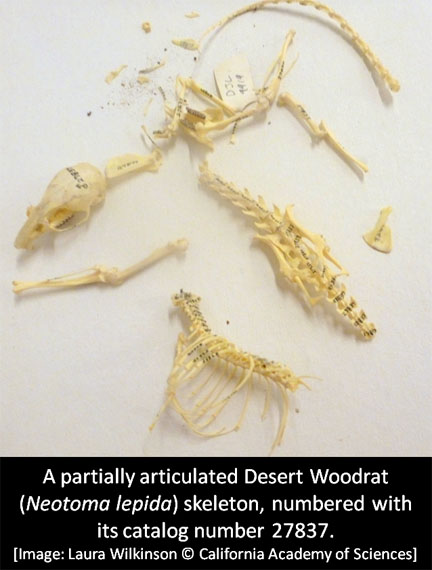Recently, I’ve been working in the Project Lab on a different kind of task than usual: numbering bird and mammal skeletons. While I’m usually busy preparing research specimens for our collections, there are other steps that bridge the time a specimen is prepared to the time that it can be integrated into our collection. With study skins, this involves allowing the skin to dry, freezing it (to kill off any pests that may have hitched a ride during the preparation process), cataloging it (giving it a number that identifies it in our collection), and then integrating it into the collection. Skeletons, however, require the additional step of having each bone numbered after the specimen is cataloged.
I commonly get the question of whether I put a different number on each bone to identify what bone that is, helping to make putting the skeleton back together easier. The answer is: no! The number that goes on the bones is the same for each bone and is the specimen’s catalog number – its unique identification number within our system. We also keep our skeletons disarticulated, or not put together. This makes it easier for researchers to look at specific bones. For instance, if a researcher brought in a vertebra (part of the back bone) from a mystery animal and wanted to identify it by comparing it to skeletons in our collection, it would be much easier for them to compare all of the details of the bone if the skeletons were completely disarticulated.
What’s the point of all the numbering? Shouldn’t we be fine as long as we put the number on just one bone in the box? The answer again is: no! Imagine a tray of 50 boxes of skeletons. If that tray fell and each skeleton scattered, how would we know which bone goes with which specimen? This is why we put the catalog number on each bone, with the exception of tiny skeletons where the bones are too thin to write on. In those cases, we write on as many bones as possible.

Similarly, if a skeleton is mostly articulated (the bones are still attached), we still number every single bone. If the skeleton was to fall and the bones separated, we would still need each bone to have its own number.

Numbering is a slow process, but someone has to do it!
Laura Wilkinson
Curatorial Assistant and Specimen Preparator
Ornithology & Mammalogy